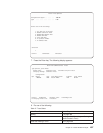
You need to tie this location to APPC over TCP/IP by adding the remote
location to the remote configuration list. See the
Communications
Configuration
book for details.
– If the host table or remote name server do not contain the location name to IP
address mapping, the APPC over TCP/IP job is not able to resolve the TCP/IP
routing to the remote location. A TCP4F05 message is logged as a
QSYSOPR message. Additionally, the QAPPCTCP job in the QSYSWRK
subsystem logs both a TCP4F04 and TCP4F05 message.
You need to tie this location to a particular IP address by adding the remote
location to IP address mapping in the host table or remote name server.
v When APPC over TCP/IP is running, the QAPPCTCP job is started in the
QSYSWRK subsystem, and for the most part will be in TIMW status. Also you
can use the Work With Connection Status option of NETSTAT to show the APPC
over TCP/IP connections. Before there are any active APPC over TCP/IP
connections, you will find an APPCoverTCPIP entry for both a *UDP and Listen
State connection on local port 397. These are both waiting for incoming APPC
over TCP/IP traffic.
If both of these situations are not true, make sure TCP/IP is started and that the
ALWANYNET (Allow AnyNet) network attribute is set to *YES.
Tracing APPC over TCP/IP Problems
When a valid APPC over TCP/IP problem occurs, you may need to perform a SLIC
trace to capture the problem.
Multiprotocol Transport Network (MPTN) is an option of the Component Trace
option of SLIC Trace (just as TCP/IP is). Choosing MPTN and the option beneath it
called APPC over TCP/IP will take a SLIC trace of APPC over TCP/IP traffic.
Collecting a Communications Trace
A communications trace can be used to isolate errors. Communications traces can
be run from SST or using the following CL commands:
v Check Communications Trace (CHKCMNTRC)
v Delete Communications Trace (DLTCMNTRC)
v End Communications Trace (ENDCMNTRC)
v Print Communications Trace (PRTCMNTRC)
v Start Communications Trace (STRCMNTRC)
You should be able to use the communications line while the communications trace
is running. You should know the name of the line before starting the procedure. In
order to determine the line that you need to trace for TCP/IP problems, look at the
interface you defined and what line description that interface uses.
Note: Contact the security officer or system administrator to get service authority to
use SST. This authority is necessary to use SST.
Planning to Set up a Trace
Before starting to work with a communications trace:
1. If you have not created the library IBMLIB or output queue IBMOUTQ, enter the
following commands:
Chapter 21. TCP/IP Problem Analysis 493


















